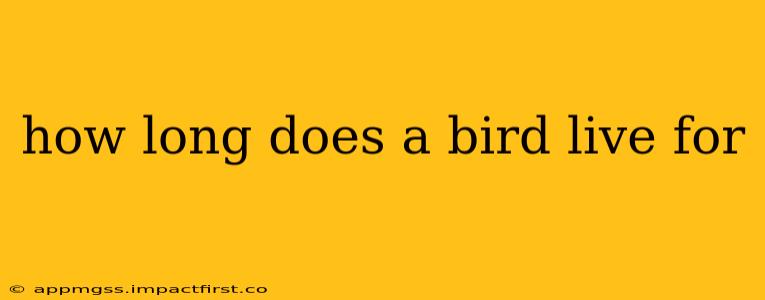How Long Does a Bird Live For? A Comprehensive Guide to Avian Lifespans
The lifespan of a bird is incredibly diverse, varying wildly depending on species, habitat, and environmental factors. There's no single answer to "how long does a bird live for?" Some species live for mere years, while others can reach impressive ages. Understanding the factors influencing avian longevity helps us appreciate the remarkable diversity within the avian world.
What are the factors influencing a bird's lifespan?
Several factors significantly influence how long a bird lives. These include:
- Species: This is perhaps the most significant determinant. Tiny hummingbirds, for example, typically live only 3-5 years, while some large parrots can live for decades, even exceeding 80 years in captivity. Large raptors like eagles and vultures also often boast impressive lifespans.
- Habitat: Birds living in stable, resource-rich environments tend to live longer than those in harsh or unpredictable habitats. Access to food, shelter, and breeding sites all contribute to survival.
- Predation: The risk of predation significantly impacts lifespan. Birds that are prey for other animals naturally have shorter lifespans.
- Disease: Avian diseases can drastically reduce lifespans, particularly in crowded or stressed populations.
- Human Impact: Habitat loss, pollution, and climate change negatively impact bird populations and their lifespans. Collisions with human-made structures also contribute to premature mortality.
- Captivity vs. Wild: Birds in captivity, particularly those receiving proper care, often live longer than their wild counterparts. This is because they are protected from many of the risks mentioned above.
How long do different types of birds live?
Let's examine the lifespans of some common bird types:
- Small Songbirds: These typically have shorter lifespans, often ranging from 2-5 years. Examples include robins, sparrows, and warblers.
- Larger Songbirds: Larger songbirds tend to live longer, with some species reaching 10-15 years. Examples include jays, starlings, and blackbirds.
- Raptors (Eagles, Hawks, Owls): Many raptors are known for their impressive lifespans, often living for 20-30 years or more in the wild. Some species, like bald eagles, can live well into their 30s.
- Parrots: Certain parrot species are renowned for their exceptionally long lifespans. Some macaws and cockatoos can live for 50-80 years or even longer in captivity.
- Waterfowl (Ducks, Geese, Swans): Lifespans vary greatly among waterfowl. Some ducks may live only a few years, while geese and swans can live for 10-20 years or more.
Do birds age like humans?
No, birds don't age in the same way as humans. Their aging processes differ in several aspects. While they experience declines in physical function and reproduction with age, the rate and nature of these declines vary considerably between species. Furthermore, understanding how birds age is an ongoing area of scientific research.
What are the signs of an aging bird?
Signs of aging in birds can vary greatly depending on the species. However, some common signs include:
- Decreased physical activity: Older birds may become less active and less agile.
- Changes in plumage: Feathers may become duller, less vibrant, or more ragged.
- Weakened immune system: Older birds may become more susceptible to diseases and infections.
- Difficulty foraging: Finding and obtaining food can become challenging.
How can I help birds live longer?
Protecting bird habitats, reducing pollution, and minimizing human-caused threats are crucial for ensuring the survival and longevity of bird populations. Supporting conservation efforts and practicing responsible birdwatching are vital steps in contributing to the well-being of these fascinating creatures.
This information provides a general overview. The specific lifespan of any given bird is subject to numerous individual and environmental factors. Consulting specialized ornithological resources can offer more detailed information on the lifespans of specific bird species.
